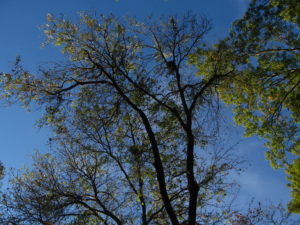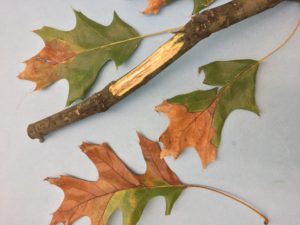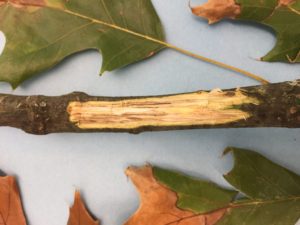Oak wilt has been found in most counties in Indiana and is one of the most serious threats to the health of oak trees in the Midwest, especially those in the red oak / black oak group. The disease is caused by the fungus Ceratocystis fagacearum and is spread from tree to tree by sap feeding beetles and by natural root grafts between trees. Beetles carry spores of the fungus from infected trees to fresh wounds leading to infections in the canopy. Root of oaks of the same species nearby normally join as grafts when they grow together, providing the other means of spread from one infected tree to other nearby oaks.
Trees in the red oak and black oak group are highly susceptible. When infected early in the summer red oaks usually wilt rapidly, show extensive summer leaf drop and may die by fall, or spring of the year following infection (Fig. 1). Initial symptoms include leaf browning from the tips or along one side (Fig. 2), but the key symptom to look for is discoloration of the vascular tissues, resulting in dark streaks in the sapwood (Fig. 3).
- Fig 1: Red oak canopy showing leaf loss and rapid decline.
- Fig. 2: Red oak leaves showing necrosis at tips and along side.
- Fig. 3: Red oak branch showing dark streaks in vascular tissue of sapwood.
Bur oak is intermediate in susceptibility and may survive 3-5 years after infection. White oaks are more tolerant and have a slower decline over many years, with individual branches dying (Fig. 4).
Prevention is key with this disease because so little can be done for red oaks after the infection is discovered.
Prevent infection by beetles:
– Don’t prune, wound or remove oaks in known oak wilt areas from March-August.
– Apply wound dressing paint to unavoidable wounds during this period.
– Remove bark from red oaks that have died from oak wilt to prevent formation of fungal mats
– November through February: Save period to prune because the fungus and insects are inactive.
Prevent infection by root grafts:
– If oak wilt has been confirmed then cutting root grafts is recommended where practical between trees oaks of the same species.
– If planting new trees consider planting a variety of tree species
Additional recommendations and more detail on this disease are provided in our publication:
https://www.extension.purdue.edu/extmedia/BP/BP-28-w.pdf
Confirmation of a suspected oak wilt infection requires laboratory testing of the branches showing dark streaks in the sapwood. If you suspect oak wilt, the Purdue Plant and Pest Diagnostic Lab (PPDL) can test samples for the presence of the fungus. You may want to consult a certified arborist to help you collect wilting branches from the crown of the tree. You can find an arborist at www.treesaregood.org/findanarborist.
See our guidelines on how to collect and ship a sample for oak wilt testing:



